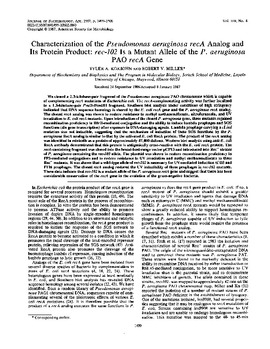| dc.contributor.author | Kokjohn, Tyler A. | |
| dc.contributor.author | Miller, Robert V. | |
| dc.date.accessioned | 2015-10-16T20:48:32Z | |
| dc.date.available | 2015-10-16T20:48:32Z | |
| dc.date.issued | 1987-04 | |
| dc.identifier | okds_Miller_JB_1987-04.pdf | |
| dc.identifier.citation | Kokjohn, T. A., & Miller, R. V. (1987). Characterization of the Pseudomonas aeruginosa recA analog and its protein product: rec-102 is a mutant allele of the P. aeruginosa PAO recA gene. Journal of Bacteriology, 169(4), 1499-1508. https://doi.org/10.1128/jb.169.4.1499-1508.1987 | |
| dc.identifier.uri | https://hdl.handle.net/11244/19934 | |
| dc.description.abstract | We cloned a 2.3-kilobase-pair fragment of the Pseudomonas aeruginosa PAO chromosome which is capable of complementing recA mutations of Escherichia coli. The recA-complementing activity was further localized to a 1.5-kilobase-pair Pvull-HindIl fragment. Southern blot analysis under conditions of high stringency indicated that DNA sequence homology is shared by the E. coli recA gene and the P. aeruginosa recA analog. The cloned recA analog was shown to restore resistance to methyl methanesulfonate, nitrofurantoin, and UV irradiation to E. coli recA mutants. Upon introduction of the cloned P. aeruginosa gene, these mutants regained recombination proficiency in HfrH-mediated conjugation and the ability to induce lambda prophages and SOS functions (din gene transcription) after exposure to DNA-damaging agents. Lambda prophage carrying a cI Ind mutation was not inducible, suggesting that the mechanism of induction of these SOS functions by the P. aeruginosa RecA analog is similar to that by the activated E. coli RecA protein. The product of the recA analog was identified in minicells as a protein of approximately 47,000 daltons. Western blot analysis using anti-E. coli RecA antibody demonstrated that this protein is attigenicaiy cross-reactive with the E. coli recA protein. The recA-containing fragment was cloned into the broad-host-range vector pCP13 and introduced into Rec- strains of P. aeruginosa containing the rec-102 allele. The plasmid was shown to restore recombination proficiency in FP5-mediated conjugations and to restore resistance to UV irradiation and methyl methanesulfonate to these Rec- mutants. It was shown that a wild-type allele of rec-102 is necessary for UV-mediated induction of D3 and F116 prophages. The cloned recA analog restored the UV inducibility of these prophages in rec-102 mutants. These data indicate that rec-102 is a mutant altele of the P. aeruginosa recA gene and suggest that there has been considerable conservation of the recA gene in the evolution of the gram-negative bacteria. | |
| dc.format | application/pdf | |
| dc.language | en_US | |
| dc.publisher | American Society for Microbiology | |
| dc.rights | This material has been previously published. In the Oklahoma State University Library's institutional repository this version is made available through the open access principles and the terms of agreement/consent between the author(s) and the publisher. The permission policy on the use, reproduction or distribution of the material falls under fair use for educational, scholarship, and research purposes. Contact Digital Resources and Discovery Services at lib-dls@okstate.edu or 405-744-9161 for further information. | |
| dc.title | Characterization of the Pseudomonas aeruginosa recA analog and its protein product: rec-102 is a mutant allele of the P. aeruginosa PAO recA gene | |
| osu.filename | okds_Miller_JB_1987-04.pdf | |
| dc.description.peerreview | Peer reviewed | |
| dc.identifier.doi | 10.1128/jb.169.4.1499-1508.1987 | |
| dc.description.department | Microbiology and Molecular Genetics | |
| dc.type.genre | Article | |
| dc.type.material | Text | |
